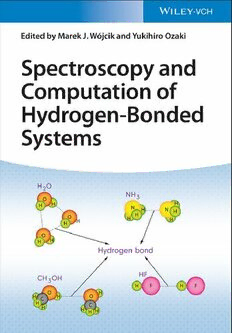
Spectroscopy and Computation of Hydrogen-Bonded Systems PDF
Preview Spectroscopy and Computation of Hydrogen-Bonded Systems
SpectroscopyandComputationofHydrogen-BondedSystems Spectroscopy and Computation of Hydrogen-Bonded Systems Edited by Marek J. Wójcik and Yukihiro Ozaki Editors AllbookspublishedbyWILEY-VCHarecarefully produced.Nevertheless,authors,editors,and Prof.MarekJ.Wójcik publisherdonotwarranttheinformation JagiellonianUniversity containedinthesebooks,includingthisbook, FacultyofChemistry tobefreeoferrors.Readersareadvisedtokeep Gronostajowa2 inmindthatstatements,data,illustrations, 30-387Krakow proceduraldetailsorotheritemsmay Poland inadvertentlybeinaccurate. Prof.em.YukihiroOzaki KwanseiGakuinUniversity LibraryofCongressCardNo.:appliedfor DepartmentofChemistry 2-1Gakuen BritishLibraryCataloguing-in-PublicationData KobeSandaCampus Acataloguerecordforthisbookisavailable 669-1337Sanda,Hyogo fromtheBritishLibrary. Japan Bibliographicinformationpublishedby CoverImage:©EmreTerim/Shutterstock theDeutscheNationalbibliothek TheDeutscheNationalbibliotheklists thispublicationintheDeutsche Nationalbibliografie;detailedbibliographic dataareavailableontheInternetat <http://dnb.d-nb.de>. ©2023WILEY-VCHGmbH,Boschstraße12, 69469Weinheim,Germany Allrightsreserved(includingthoseof translationintootherlanguages).Nopartof thisbookmaybereproducedinanyform–by photoprinting,microfilm,oranyother means–nortransmittedortranslatedintoa machinelanguagewithoutwrittenpermission fromthepublishers.Registerednames, trademarks,etc.usedinthisbook,evenwhen notspecificallymarkedassuch,arenottobe consideredunprotectedbylaw. PrintISBN:978-3-527-34972-2 ePDFISBN:978-3-527-83489-1 ePubISBN:978-3-527-83490-7 oBookISBN:978-3-527-83491-4 Typesetting Straive,Chennai,India v Contents PartI Theory 1 1 LinearResponseTheoryApplicationstoIRSpectraof H-BondedCyclicDimersTakingintoAccounttheSurrounding. UpdatingContributionsInvolvingDavydovCoupling,Fermi ResonancesandElectricalAnharmonicity 3 PaulBlaiseandOlivierHenri-Rousseau 1.1 Introduction 3 1.2 DimerStrongAnharmonicCouplingTheory 3 1.2.1 DifferentTheoreticalSituations 3 1.2.1.1 StrongAnharmonicCouplingWithinAdiabaticApproximationFor Monomer 3 1.2.1.2 IntroductionofFermiResonances 6 1.2.1.3 H-BondedCentrosymmetricDimer 8 1.2.1.4 DimerInvolvingDamping,DavydovCoupling,andFermi Resonances 12 1.2.2 TheSpectralDensity 13 1.3 ComparisonwithExperiments 14 1.3.1 CarboxylicAcidDimersIgnoringFermiResonances 14 1.3.1.1 GaseousandLiquidAceticAcidDimers 14 1.3.1.2 GaseousAcrylicandPropynoicAcids 15 1.3.2 CarboxylicAcidsTakingIntoAccountFermiResonances 16 1.3.2.1 CrystallineAdipicAcid 16 1.3.2.2 CrystallinePolarizedandUnpolarizedGlutaricAcidTakingInto AccountFermiResonances 17 1.3.2.3 CrystallineThiopheneaceticAcidandThiopheneacrylicAcids 17 1.3.2.4 l.2-NaphtylaceticAcid(2-NA)Crystals 20 1.3.2.5 CrystallineAspirinDimersInvolvingSlowModeMorsePotential 23 1.3.2.6 PhthalicandTerephthalicAcidCrystals 25 1.3.2.7 LiquidFormicAcidMixingofMonomerandDimer 27 vi Contents 1.3.2.8 CrystallineFuroicAcidDimerwithSlowModeMorsePotentialand FermiResonances 28 1.3.2.9 OtherKindsofH-BondedCompounds 31 1.3.2.10 PhosphinicAcidDimer 31 1.3.2.11 Monomerof(CH ) O···HCl 33 3 2 1.4 Conclusion 36 1.5 Acknowledgment 36 References 36 2 DynamicInteractionsShapingVibrationalSpectraof Hydrogen-BondedSystems 39 MarekJ.Wójcik,MateuszBrela,ŁukaszBoda,MarekBoczar,andTakahito Nakajima 2.1 Introduction 39 2.2 TheoreticalModeloftheInfraredSpectraofGaseous(CH ) O-HCland 3 2 (CH ) O-HFComplexes 42 3 2 2.3 SimulationoftheCl–H(D)andF–HStretchingBandsinthe DME-H(D)ClandDME-HFComplexes 45 2.4 MethodologyofMolecularDynamics 47 2.5 SpectroscopicStudyofUracil,1-Methyluracil,and 1-Methyl-4-thiouracil 49 2.6 HydrogenBondInteractionDynamicsintheAdenineandThymine Crystals 50 2.7 GuanineandCytosineCrystals 51 2.8 SpectroscopicSignatureforFerroelectricIce 52 2.9 Conclusions 55 Acknowledgment 56 References 56 3 TrajectoryOn-the-FlyMolecularDynamicsApproachto TunnelingSplittingintheElectronicGroundandExcited States 67 TetsuyaTaketsuguandYusukeOotani 3.1 Introduction 67 3.2 SemiclassicalTunnelingApproach 69 3.3 ResultsandDiscussion 71 3.3.1 UmbrellaInversionofAmmonia 72 3.3.2 IntramolecularHydrogenTransferinMalonaldehyde 73 3.3.3 ExcitedStateIntramolecularHydrogenTransferinTropolone 75 3.4 Conclusions 79 Acknowledgments 79 References 80 Contents vii PartII Spectroscopy 83 4 SpectroscopicSignaturesofLow-BarrierHydrogenBondingin NeutralSpecies 85 LidorFoguel,ZacharyN.Vealey,andPatrickH.Vaccaro 4.1 Introduction 85 4.2 SpectroscopicMetricsforHydrogenBonding 87 4.2.1 ContinuumofHydrogenBonding 87 4.2.2 RelationshiptoTunneling 92 4.2.3 Ground-StatePropertiesofModelSystems 93 4.2.4 Excited-StateSpectroscopyof6-Hydroxy-2-Formylfulvene 98 4.2.5 Ground-StateSpectroscopyof6-Hydroxy-2-Formylfulvene 102 4.2.6 Excited-StatePropertiesofModelSystems 105 4.3 ConcludingRemarks 108 Acknowledgments 109 References 109 5 Hydrogen-BondingInteractionsUsingExcess Spectroscopy 123 YaqianWangandZhiwuYu 5.1 IntroductionofHydrogenBond 123 5.1.1 DefinitionofHydrogenBond 123 5.1.2 TheCriteriaoftheExistenceofHydrogenBonds 124 5.1.3 TheStrengthofHydrogenBonds 125 5.2 TheoryofExcessspectroscopy 126 5.3 StudiesofHydrogenBondsbyExcessIR 129 5.3.1 ClassicalHydrogenBonds 129 5.3.2 ChargeAssistedHydrogenBonds 131 5.3.3 CooperativeResonance-AssistedHydrogenBonds 134 5.3.4 Weak/ModerateHydrogenBonds 138 References 142 6 IntramolecularHydrogenBondinginPorphyrinIsomers 145 JacekWaluk 6.1 Introduction 145 6.2 H-BondCharacteristics 146 6.2.1 Porphine(1) 147 6.2.2 Porphycene(2) 148 6.2.3 Hemiporphycene(3) 150 6.2.4 Corrphycene(4) 152 6.2.5 Isoporphycene(5) 154 6.2.6 Porphyrin-(2.2.0.0)(6) 156 viii Contents 6.2.7 Porphyrin-(3.1.0.0)(7) 157 6.2.8 Porphyrin-(4.0.0.0)(8) 158 6.2.9 Inverted/ConfusedPorphyrin(9) 162 6.2.10 Neo-confusedPorphyrin(10) 164 6.3 CorrelationsBetweenGeometryandHBStrength 165 6.4 ParametersThatCanDescribetheHBStrength 167 6.5 TautomerizationMechanisms 168 6.6 Summary 169 Acknowledgments 170 References 170 7 IsotopeEffectsinHydrogenBondResearch 173 PoulErikHansen 7.1 Introduction 173 7.2 HydrogenBondPotentials 173 7.3 Calculations 175 7.4 HydrogenBondTypes 176 7.5 DeuteriumIsotopeEffectsonChemicalShifts 176 7.6 IntramolecularHydrogenBonds 177 7.6.1 Two-BondDeuteriumIsotopeEffectson13CChemicalShifts 178 7.6.2 Long-RangeIsotopeEffects 184 7.6.3 One-BondDeuteriumIsotopeEffectson15NChemicalShiftsin Solution 185 7.7 BiologicalSystems 185 7.7.1 Proteins 185 7.7.2 DeuteriumIsotopeEffectson1HChemicalShifts 187 7.8 IntermolecularHydrogenBonds 187 7.9 PrimaryIsotopeEffects 189 7.10 IsotopeEffectsandAcidity 191 7.10.1 IsotopeEffectstoDetermineProtonationStates 191 7.11 SolventIsotopeEffectsandExchangeRates 192 7.12 ExchangeintheSolid-State 192 7.13 HydrogenBondEnergies 193 7.14 Tautomerism 194 7.15 Solid-StateNMR 197 7.15.1 DeuteriumIsotopeEffectson15NChemicalShifts 199 7.16 Conclusions 202 References 203 8 IntramolecularHydrogenBonding:ShapingConformers’ StructureandStability 213 GulceO.IldizandRuiFausto 8.1 Introduction 213 Contents ix 8.2 TheHalogen-SubstitutedAceticAcidsCF COOH,CCl COOH,and 3 3 CBr OOH:ImplicationsofIMHBonStructureandConformers’ 3 Stabilities 215 8.3 TheSignificanceofIMHBintheorthoChloro-andFluoro-Substituted BenzoicAcids 219 8.4 IMHBinThiotropolone:SculpturingtheBidirectionalInfrared-Induced Bond-Breaking/Bond-FormingTautomerization 225 8.5 Conclusion 228 Acknowledgments 229 References 229 9 HydrogenBondingfromPerspectiveofOvertonesand CombinationModes:Near-InfraredSpectroscopicStudy 233 MirosławA.Czarnecki,YusukeMorisawa,andYukihiroOzaki 9.1 Introduction 233 9.2 InvestigationofHydrogenBondingofWaterbyNIRSpectroscopy 235 9.3 TheChainLengthEffectontheDegreeofSelf-associationof 1-Alcohols 237 9.4 CombinedNIRandDielectricStudyonAssociationof1-Hexanolin n-Hexane 240 9.5 NIRStudiesofMicroheterogeneityinAlcohol/Alcoholand Alcohol/AlkaneBinaryMixtures 241 9.6 OvertonesofνC≡NVibrationasaProbeofMolecularStructureof Nitriles 244 9.7 WeakHydrogenBondinPoly(3-Hydroxybutyrate)(PHB)StudiedbyNIR Spectroscopy 246 9.8 StudiesofHydrogenBondingByUseofHigherOvertones 249 9.9 ComparisonofHydrogenBondingEffectsandSolventEffectsonWave numbersandIntensitiesoftheFundamentalandFirstOvertoneofthe N–HStretchingModeofPyrroleStudiedByNIR/IRSpectroscopyand One-DimensionalVibrationalSchrödingerEquationApproach 252 9.10 Summary 256 Acknowledgments 257 References 257 10 DirectObservationandKineticMappingofPoint-to-Point ProtonTransferofaHydroxy-PhotoacidtoMultiple (Competing)IntramolecularProtonationSites 261 DinaPines,DanEliovich,DanielAminov,MarkSigalov,DanHuppert,and EhudPines 10.1 Introduction 261 10.2 FromIntermolecularProtonTransfertoSolventtoIntramolecular Point-to-PointTransferin1:1Hydrogen-BondingComplexesofWater withBifunctionalOHPhotoacids 270 x Contents 10.3 WaterIsAbletoDonateandAcceptanH-bondasDemonstratedbyIR Absorptionin1:1Water–(AcidorBase)Complexes 273 10.4 ProtonTransferAlongwithWaterBridgesinAcetonitrile(ACN) SpanningtheDistanceBetweenanAcidicandaBasicSideGroupsof BifunctionalPhotoacids 274 10.5 Time-ResolvedFluorescenceMeasurementsofProtonTransferalong withWaterBridges 277 10.6 IsotopeD/HEffect 283 10.7 InsightsintotheMechanismofProtonTransferThroughOne-Water BridgeinBifunctional2-Naphthols 285 10.8 Summary 288 Acknowledgments 289 References 289 11 SpectroscopicDeterminationofHydrogenBond Energies 293 MausumiGoswamiandElangannanArunan 11.1 Introduction 293 11.2 BindingEnergyMeasurementInvolvingInfrared(IR)Excitation 296 11.2.1 MeasurementoftheDissociationEnergyofH-BondedComplexes ThroughVibrationalPre-dissociationDynamicsviaInfrared Excitation 296 11.2.1.1 OptothermalBolometricDetermination 297 11.2.1.2 VelocityMapImaging 299 11.2.2 DeterminationofGibbsFreeEnergyofH-BondedComplexFormation ByInfraredSpectroscopy 307 11.2.3 MeasurementofBindingEnergyofH-BondedComplexesbyIR–UV DoubleResonanceSpectroscopy 314 11.3 DeterminationoftheBindingEnergyofH-BondedComplexesUsing SpectroscopicTechniquesInvolvingElectronicExcitation 316 11.3.1 DeterminationofH-BondDissociationEnergyThroughMultiphoton IonizationTechniques 316 11.3.2 DeterminationoftheDissociationEnergyofCationicH-Bonded ComplexesThroughBirge–SponerExtrapolation 325 11.3.3 DeterminationoftheDissociationEnergyofH-BondedComplexesUsing SEP-REMPITechnique 328 11.4 EstimationoftheWellDepthofH-BondingInteractionsThrough MicrowaveSpectroscopy 332 11.5 Conclusion 335 References 336 12 IRandNMRSpectralDiagnosticsofHydrogenBondEnergy andGeometry 345 PeterM.TolstoyandElenaYu.Tupikina 12.1 Introduction 345
